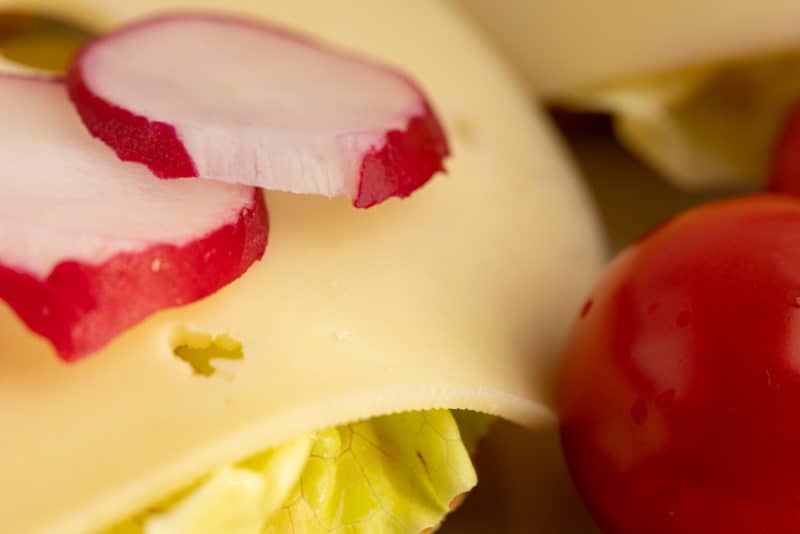

Just go straight down though the soft cheese. Just wrap ends of the floss around your hands/fingers and pull real tight for this, forming a length of string only slightly longer than the cheese is wide. Oil an appropriate length of dental floss, and use it to cut your first slice. Brush oil over the top of the entire block of cheese, and pour a little oil into the storage container (meaning the oil from the freezer). Wasting no time, remove the block of cheese from the frig and place it on the stone plate. Brush a thin layer of oil uniformly over the center of the wax paper, covering an area just larger than that of the block of cheese. Place your opened oil container (the one you'll be storing the bricks in) to your right or left (depending on which hand you are). Place your refrigerated stone plate onto your work surface, Cover it with that large sheet of refrigerated wax paper. You'll also want a bar towel to clean the knife off with as you work. Set up your work surface with these items about the perimeter. Place it right back in the frig.įor cutting you will need an ample supply of unwaxed dental floss, a long thin-bladed knife (carving knife), a small kitchen brush (flat and broad), and a shallow bowl of refrigerated vegetable oil. Temporarily remove the block of cheese from the refrigerator, just long enough to remove it from its wrapper and score it along its top side, making marks wherever you intend to cut it. So once you get started with the cutting process your aim is to work as quickly though safely as possible.

The general principle is to keep everything down below room temperature as much as possible. If you own stone plates of any sort, (a pizza stone will do just fine), go ahead and refrigerate one of those as well (or freeze it if there's room for it). Refrigerate them too, that and one large sheet for your work surface.
#HOW DO YOU MAKE CHEESE LAST LONGER PLUS#
Separately, prepare sheets of wax paper, the dimensions of which are the same size as the broad side of each individual brick of cheese, (whatever size you choose), plus of course just a slight amount of overlap (especially on one end). Also add the container you'll be using to store the bricks of cheese in. Vegetable oil cannot freeze in a typical household freezer. Place a medium-size bottle of vegetable oil in the freezer, and leave it there long enough for it to come down to freezer temps. Place the whole block of cheese in the refrigerator and leave it there long enough for it to come down to refrigerator temps this will make it easier to cut it without deforming it, leaving you nice clean little bricks to work with and enjoy. But this method will preserve the cheese for several months in an airtight environment. Obviously you're not limited to the configuration you described. I suggest freezing it in oil (so that ice crystals do not form), according to the following procedure:Īcquire a sealable plastic container, such as Tupperware, just a bit larger than the total amount of space (volume) the stored cheese will occupy. (This picture is from Sam's Club, but I think the other big warehouse store carries the small packs too.) Quite a deal for less than $2 more, epecially if the sell-by date is well out. You can't just cut off the moldy parts like you can on hard cheese.ĮDIT: Just FYI, some places in the US that sell the 48 ounce brick also sell 50 count, 1 ounce packages. In the fridge, just watch for mold, toss the whole thing if it develops mold. Of course it will stay safe in the freezer indefinitely. They suggest (for quality only, not safety), keeping opened cream cheese in the freezer for only two months. Again, Still Tasty is a bit (IMO) overly conservative. Frozen, it will lose some creaminess, but will still be good in cooked applications. I'd try for keeping a month's worth, refrigerated, in well wrapped packages that you won't open until the last one is gone. Very well packed (well wrapped or preferably vacuum packed) cream cheese really should last longer than that. Still Tasty recommends that you use opened, refrigerated cream cheese within a couple of weeks. Cut it in slices that you will use within a week. The "best before" date is usually way out.


 0 kommentar(er)
0 kommentar(er)
